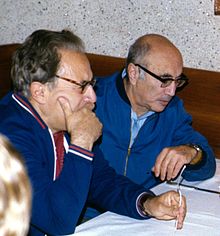Iossif Samuilowitsch Schklowski

Iosif Shklovsky ( Russian Иосиф Самуилович Шкловский , also Josef Shklovsky and Iosif Shklovsky transcribed; * June 18 jul. / 1. July 1916 greg. In Hlukhiv , Russian Empire ; † 3. March 1985 in Moscow ) was a Soviet astronomer and Astrophysicist .
Life
Josef S. Schklowski completed his physics studies at the Moscow State University in 1938 , received an apprenticeship at the Sternberg Institute for Astronomy and stayed there after completing it. In 1943 he defended his dissertation . Because of his bad eyesight, he was released from military service.
His field of work was theoretical astrophysics; especially radio astronomy . In 1953 he became professor and head of the radio astronomy department at the Sternberg Institute. In the same year, he suggested that the blue lights of the center of the Crab Nebula by synchrotron radiation to explain. For the hydroxyl radical , he predicted its microwave radiation .
With the beginning of space travel , Schklowski had the idea of creating an "artificial comet " for the navigation of space probes . According to the concept he developed, the first lunar missions Lunik 1 and Lunik 2 each emitted a sodium cloud . In 1960 he was awarded the Lenin Prize for this concept (за концепцию искусственной кометы) .
Among other things, Schklowski is considered a pioneer in the research of SETI and was co-organizer of the first conferences at the Byurakan Observatory on possibly existing extraterrestrial civilizations in the 1960s . In 1964 he became a member of the Royal Astronomical Society , in 1966 a corresponding member of the Academy of Sciences of the USSR and a member of the American Academy of Arts and Sciences . In 1968 Shklowski founded a new department at the Institute for Cosmos Research of the Academy of Sciences of the USSR. In 1973 he became a member of the National Academy of Sciences and the Royal Astronomical Society of Canada . In 1972 he was awarded the Bruce Medal .
In later years he also devoted himself to popularizing science and wrote some popular science books.
The asteroid (2849) Shklovskij was named after Josef S. Schklowski .
membership
In 1967 Schklowski was elected to the American Academy of Arts and Sciences , in 1973 to the National Academy of Sciences .
Works
- IS Shklovsky: Cosmic Radio Waves . Harvard University Press, Cambridge 1960
- IS Shklovsky: Вселенная, жизнь, разум . USSR Academy of Sciences Publisher, Moscú 1962
- IS Shklovsky: Physics of the Solar Corona . Pergamon Press, Oxford 1965
- IS Shklovskii: Supernovae . Wiley, New York 1968
- IS Shklovsky: Stars: Their Birth, Life, Death . San Francisco 1978, ISBN 0-7167-0024-7
- IS Shklovsky: Five Billion Vodka Bottles to the Moon: Tales of a Soviet Scientist , WW Norton & Company, 1991.
- IS Shklovsky, Carl Sagan : Intelligent life in the universe. Holden-Day, San Francisco 1966
literature
- Iossif Samuilowitsch Schklowski July 1, 1916 to March 3, 1985 . In: Die Sterne , Volume 61 (1985), Issue 4, pp. 232-234.
Web links
- Biography on krugosvet.ru (Russian)
- Biography (English)
- Article Iossif Samuilowitsch Schklowski in the Great Soviet Encyclopedia (BSE) , 3rd edition 1969–1978 (Russian)
Individual evidence
- ↑ Personenlexikon.net: Schklowski, Jossif Samuilowitsch
- ↑ On the launch of the third Soviet cosmic missile . In: The Soviet Union Today . No. 29 (4th year), October 10, 1959, p. 5 (Online: http://epizodsspace.no-ip.org/bibl/inostr-yazyki/nemets/die-sowjetunion-heute/1959/start -no_29.pdf (Wikipedia spam filter blocked because of no-ip ))
- ↑ sm.evg-rumjantsev.ru: Иосиф Самуилович Шкловский ( July 1, 1916 - March 3, 1985 )
- ^ David W. Swift: SETI pioneers - scientists talk about their search for extraterrestrial intelligence. University of Arizona Press, Tucson 1990, ISBN 0-8165-1119-5 . Pp. 167-177.
- ^ Conference on Extraterrestrial Civilizations Soviet Astronomy, Vol. 9, p.369@nasa ads
- ↑ 2849 Shklovskij (1976 GN3) JPL Small-Body Database Browser; 2849 Shklovskij en.wikipedia (Retrieved May 12, 2010)
- ↑ Book of Members 1780 – present, Chapter S. (PDF; 1.4 MB) In: American Academy of Arts and Sciences (amacad.org). Retrieved March 22, 2018 .
| personal data | |
|---|---|
| SURNAME | Schklowski, Iossif Samuilowitsch |
| ALTERNATIVE NAMES | Schklowski, Josef Samuilowitsch; Шкловский, Иосиф Самуилович (Russian); Shklovsky, Iosif |
| BRIEF DESCRIPTION | Soviet astronomer and astrophysicist |
| DATE OF BIRTH | July 1, 1916 |
| PLACE OF BIRTH | Hluchiw , Russian Empire |
| DATE OF DEATH | March 3, 1985 |
| Place of death | Moscow |
